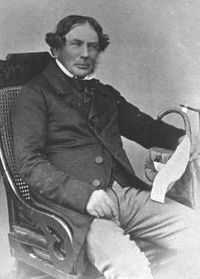John Helder Wedge
John Helder Wedge (1793 – 22 November 1872) was a surveyor, explorer and politician in Van Diemen's Land (now Tasmania, Australia).[1]

Wedge was the second son of Charles Wedge of Shudy Camps, Cambridge, England.[1] John Wedge learned the basics of surveying from his father. Due to financial losses during the post-war depression in agriculture, Wedge and his brother Edward decided to migrate to Van Diemen's Land; before leaving London Wedge had obtained an appointment in the colony as assistant surveyor.
Van Diemens Land
The brothers arrived in Van Diemen's Land aboard the Heroine[1] on the morning of the 15th of April 1824.[2] Wedge led several expeditions through heavily timbered and mountainous country in the north-east and central highlands of the island. On one of these journeys Wedge he found a camp of the bushrangers led by Matthew Brady. For Wedge's efforts in their capture he was rewarded with a land grant in 1826; later he applied for another grant for the capture of five absconders. Wedge was sent to the far north-west in 1828 to examine the lands of the Van Diemen's Land Company. Wedge reported much rich soil in the heavily timbered area but the Company wanted pasture land immediately available and disputed the accuracy of Wedge's map. Part of Wedge's work included investigating grants surveyed earlier by George Evans and Thomas Scott who were both accused of receiving bribes for measuring more than the authorized area to settlers. Wedge proved that the accusations were well founded.[1]
A large expedition was organized by the surveyor-general, George Frankland, in February 1835 to explore the country lying between the Derwent, Gordon and Huon Rivers. Wedge, as leader of one of the parties, proved a resourceful and intelligent bushman, covering much difficult territory. Wedge won Frankland's praise for his efforts in the Survey Department whose staff was overworked. Wedge was keen for promotion and came to believe that his hopes were being frustrated by nepotism at the Colonial Office. In his survey work Wedge had often visited John Batman at Kingston, and together they planned an expedition across Bass Strait.[1]
Port Phillip District
When Batman returned from his first visit in 1835 Wedge resigned from the Survey Department and crossed to Port Phillip, arriving on 7 August 1835[3] where he explored along the Barwon River and surveyed the 600,000 acres (2,400 km2) 'acquired' by Batman's Port Phillip Association from the Indigenous Australians. Wedge arrived the site of Melbourne on 2 September 1835, where he discovered members of a party organized by John Pascoe Fawkner.[3] Wedge was against the forceful removal of Fawkner's party by its rivals, and played an important part in the founding of the settlement of Melbourne.[1] Wedge named the Yarra River on 13 September 1835.[3] Wedge was one of the first to bring over sheep from Tasmania, to his station at Werribee. Wedge also reported to Lieutenant-Governor Arthur on the wild white man, William Buckley, whose pardon he recommended, and on outrages against the Aboriginals, for whose hopeless condition he had much compassion. He had earlier adopted an Aboriginal boy, May Day, rescued from the surf near Circular Head, Victoria. His 'Narrative of an excursion amongst the natives of Port Phillip' and a 'Description of the country around Port Phillip' were among the expedition papers published as a Tasmanian parliamentary paper (1885). The Journal of the Royal Geographical Society (1836) printed Wedge's paper 'On the country around Port Phillip, South Australia'. The diaries of his explorations and survey work were sent to his father in England; the Royal Society of Tasmania published them in 1962.[1]
From 1838-43 Wedge visited England; on the death of his father he returned to Tasmania to find his finances reduced by economic depression. In 1843 Wedge married Maria Medland Wills, who had been governess to Bishop Francis Russell Nixon's children, but within a year she died in childbirth. Wedge was then appointed by Nixon from 1846-51 to manage the farms which formed the endowment of Christ's College at Bishopsbourne. In 1855 Wedge was elected to the district of Morven in Tasmanian Legislative Council. Wedge held office in the short-lived ministry of Thomas Gregson in 1857, as member for North Esk, and initiated the inquiry into the convict department under its comptroller, Stephen Hampton. Wedge was an active Anglican; one of his last acts before withdrawing from parliament in 1868 was to support the commutation bill that granted £100,000 to religious denominations in place of annual state aid. Wedge died on 22 November 1872 at his home Medlands which he had built on the Forth River in 1865.[1]
References
- ↑ 1.0 1.1 1.2 1.3 1.4 1.5 1.6 1.7 G. H. Stancombe, 'Wedge, John Helder (1793 - 1872)', Australian Dictionary of Biography, Online Edition
- ↑ "Ship News". Hobart Town Gazette and Van Diemen’s Land Advertiser (Andrew Bent). 16 April 1824. p. 2. Retrieved 13 July 2010.
- ↑ 3.0 3.1 3.2 Serle, Percival (1949). "Wedge, John Helder". Dictionary of Australian Biography. Sydney: Angus and Robertson.
- J. Uhl, 'The Men from East Anglia: the Wedge Family an early pioneering family in Van Diemen's Land and Port Phillip', reprinted from the Victorian Historical Magazine Vol XXXVII No 1 (Melbourne 1966);
- Crawford et al. (editors) The Diaries of John Helder Wedge, Royal Society of Tasmania, (Hobart 1962); Correspondence File for Wedge in Tasmanian Archives)
- Parliamentary library profile
External links
- Images and transcript of John Helder Wedge's field book
- Map of Port Phillip at the State Library of Victoria
| Tasmanian Legislative Council | ||
|---|---|---|
| New seat | Member for North Esk 1855–1860 |
Succeeded by William Gibson |
| Preceded by Thomas Horne |
Member for Hobart 1860–1866 Served alongside: Carter/Kennerley, Wilson |
Succeeded by Philip Fysh |
| Preceded by Alexander Kissock |
Member for Huon 1866–1868 |
Succeeded by John Foster |
|